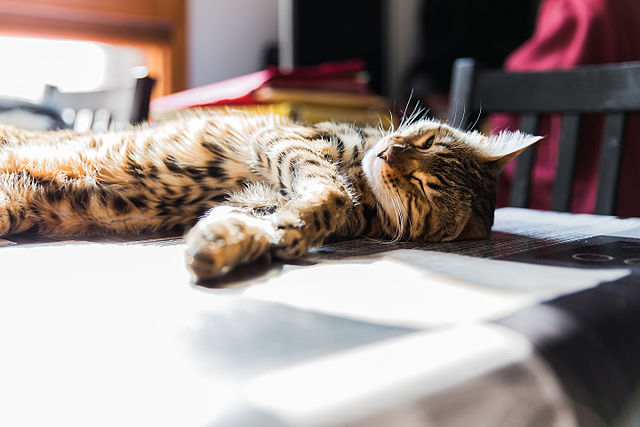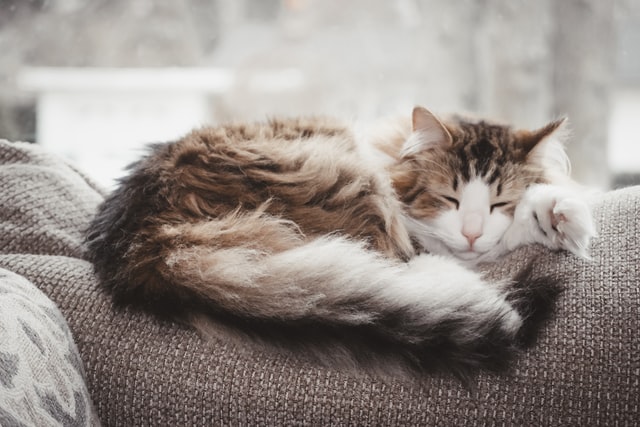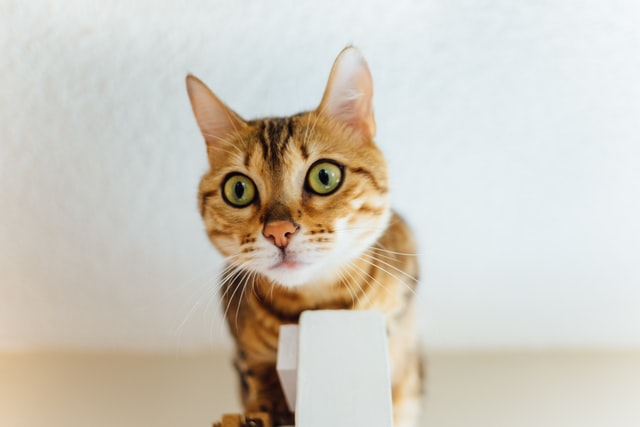Do Bengal cats shed?
No cat owner wants car fur to accumulate in their home as it’s unsightly, gets everywhere and takes time to remove.
For those with allergies, the consequences of cat shedding can be more severe.
This article answers the question as to whether Bengal cats shed and 8 others that are ‘shedding’ related and frequently asked.
What You Will Discover
- Why Bengals shed their fur
- What you can do to curb excess shedding
- Whether Bengal cats are hypoallergenic
1. Do Bengal cats shed?
Yes, Bengal cats do shed, as all domestic cats do.
However, the amount of shedding can vary among individual cats.
Bengals have a short to medium-length coat with a dense undercoat, which means they may shed moderately throughout the year, with potential increases during seasonal changes.
Now we know Bengal cats do shed, the next logical question is…
2. Why is my Bengal cat shedding?
Bengal cats, like many other cat breeds, shed their fur as part of their natural growth cycle.
Shedding is a normal process for felines and is influenced by factors such as genetics, environment, and overall health.
Reasons why your Bengal cat might be shedding include:
Seasonal Shedding
Many cats, including Bengals, shed more during seasonal changes, particularly in the spring and fall/autumn.
This shedding helps them adapt to temperature changes and prepare for the upcoming season.
Grooming Habits
Cats groom themselves regularly to keep their fur clean and healthy.
Excessive grooming can lead to increased shedding, which may be caused by stress, boredom, or skin irritation.
Diet
A balanced diet is essential for maintaining healthy skin and coat in cats.
If your Bengal cat is not receiving proper nutrition, it may experience excessive shedding or dull fur.
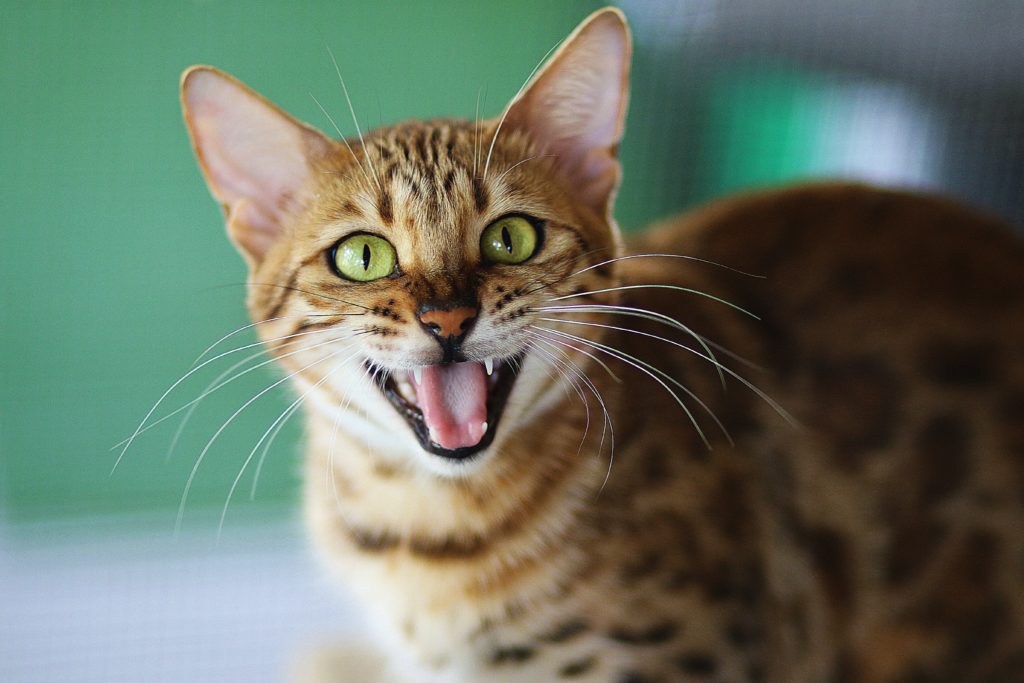
Underlying Health Issues
Certain health conditions such as allergies, parasites, hormonal imbalances, or skin infections can cause increased shedding in cats.
If you notice excessive shedding along with other symptoms like bald patches, skin irritation, or changes in behaviour, it’s essential to consult a veterinarian for proper diagnosis and treatment.
Stress
Felines can experience stress due to changes in their environment, routine, or social interactions.
Cat shedding due to stress may occur in response to factors such as moving to a new home, the addition of a new pet or family member, or changes in their daily routine.
Age
Young cats, as well as senior cats, may shed more than adult cats due to hormonal changes or age-related factors.
Let’s now look at when Bengals shed the most…
3. When do Bengals shed the most?
Bengal cats, like many other cat breeds, typically shed the most during seasonal changes, particularly in the spring and fall/autumn.
This cat shedding pattern is influenced by factors such as changes in daylight length, temperature, and hormonal fluctuations.
Spring Shedding: In the spring, as the days start to lengthen and temperatures rise, Bengal cats shed their thicker winter coat to adapt to warmer weather.
This shedding helps them stay cool and comfortable during hotter months. The increased daylight triggers hormonal changes that signal the shedding process.
Fall/Autumn Shedding: Similarly, in the fall/autumn, as the days begin to shorten and temperatures cool down, Bengal cats shed their lighter summer coat to grow a thicker, warmer coat to cope with the colder months.
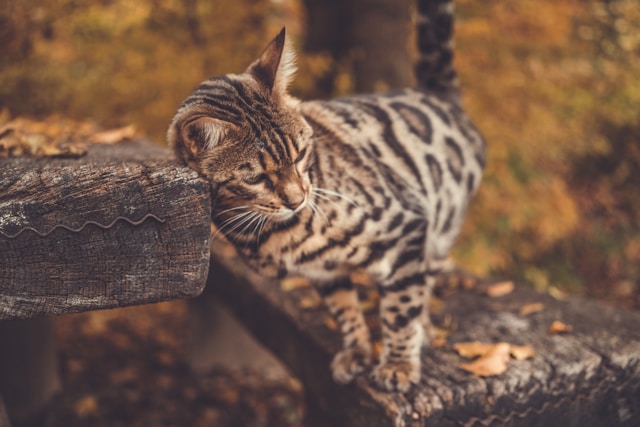
Shedding will occur all year-round to some extent, especially in indoor cats who may not experience the same environmental triggers.
So time of year can affect shedding, but what about age?
4. Do Bengal cats shed as they grow?
Yes, Bengal kittens do shed as they grow, just like other breeds of cat.
As Bengal kittens grow into adulthood, their fur may go through different phases of shedding, with some periods being more noticeable than others.
Let’s now take a look at unnaturally high levels of shedding…
5. What if my Bengal cat sheds heavily?
If your Bengal cat is shedding heavily, it’s essential to investigate the underlying cause and take appropriate steps to address it.
While shedding is a normal process for cats, excessive shedding can indicate various issues that need attention.
Here are some things you can do if your Bengal cat sheds heavily:
Visit a Veterinarian: If you notice unusually heavy shedding in your Bengal cat, it’s crucial to schedule a veterinary appointment. A veterinarian can examine your cat to determine if there are any underlying health issues contributing to the shedding, such as parasites, skin infections, allergies, hormonal imbalances, or other medical conditions.
Maintain Proper Nutrition: Ensure your Bengal cat is receiving a balanced diet that meets its nutritional needs as a poor cat diet can affect coat health and contribute to excessive shedding.
Regular Grooming: Brushing your Bengal cat regularly can help remove loose fur and minimise shedding. Use a soft-bristled brush or grooming mitt to gently remove dead hair from your cat’s coat. Regular grooming also helps distribute natural oils and keeps the coat healthy and shiny.
Manage Stress: Cats can experience stress due to various factors, including changes in their environment, routine, or social interactions. Minimise stressors in your Bengal cat’s life and provide a safe, comfortable environment. Enrichment activities, such as interactive toys and climbing structures, can help reduce stress and promote mental stimulation.
Treat Parasites: If your Bengal cat has parasites such as fleas, ticks, or mites, it’s essential to treat them promptly. Consult your veterinarian for appropriate parasite control measures, which may include topical or oral medications.
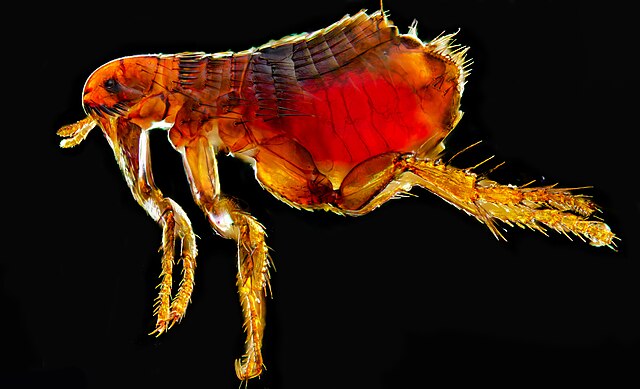
Image by Andrei Savitsky Creative Commons Attribution-Share Alike 4.0 International
Monitor Environmental Factors: Keep an eye on environmental factors that may contribute to shedding, such as temperature and humidity levels. Ensure your cat has access to fresh water and a comfortable temperature-controlled environment.
Follow Veterinary Recommendations: Follow any recommendations or treatment plans provided by your veterinarian to address the underlying cause of your Bengal cat’s excessive shedding. This may include medications, dietary changes, or lifestyle adjustments to promote overall health and well-being.
If you have any concerns about your cat’s shedding, don’t hesitate to seek guidance from your veterinarian.
Let’s look at parasites and shedding in a little more depth…
6. Are parasites common culprits for excessive shedding?
Parasites such as fleas, ticks, mites, and certain worms can irritate the skin and lead to hair loss or increased shedding.
Fleas are a common external parasite that can infest cats, causing itching, irritation, and allergic reactions.
Cats may excessively groom themselves in response to flea bites, leading to hair loss and shedding.
Indeed, an increase in the amount of scratching/grooming was something I noticed in my Bengal and led me to discover she had fleas.
Some cats are allergic to flea saliva, a condition known as flea allergy dermatitis, which can exacerbate shedding and skin issues.
Ticks can also infest cats, attaching themselves to the skin and feeding on blood. Their presence can cause skin irritation and inflammation, leading to hair loss and shedding around the infested areas.
Ear mites or mange mites can cause intense itching and irritation in cats. This can lead to scratching, hair loss, and subsequent shedding, particularly around the ears, face, and neck.
Certain intestinal worms, such as tapeworms, can deprive cats of essential nutrients, leading to poor coat condition and shedding. Severe worm infestations can cause general weakness and compromise the cat’s overall health, which may manifest in increased shedding.
It’s essential to regularly check your Bengal cat for signs of parasites, such as scratching, skin irritation, or visible parasites in the fur.
If you suspect your cat has parasites, consult your veterinarian for proper diagnosis and treatment.
And prepare for the possibility of some hard work to get rid of them.
You may be wondering how much Bengals shed compared to other cats…
7. Do Bengal cats shed less hair than other breeds of cat?
Bengal cats are not considered to be low-shedding cats like some specific cat breeds such as the Sphynx or the Cornish Rex, which have minimal or very fine fur.

However, compared to some long-haired breeds like the Maine Coon or the Persian, Bengals generally shed less hair due to their short and dense coat.
So they shed less, but are they hypoallergenic?
Find out below…
8. Are Bengal cats hypoallergenic?
Put simply, all cats, including Bengals, produce allergens, that is, substances that cause allergic reactions in those who have a cat allergy.
Although they are many claims suggesting Bengal cats are hypoallergenic (and therefore less likely to cause an allergic reaction) these claims are anecdotal and not backed-up by science.
For a more in-depth look at this subject, please read ‘Are Bengal Cats Hypoallergenic? 5 Big Myths Explored‘.
If you’re still here, we’re now going to find out how diet and fur are linked…
9. What is the best diet to keep a Bengal’s fur healthy?
To maintain a Bengal cat’s healthy fur, it’s essential to provide balanced and nutritious cat food.
All cats, including domestic cats are obligate carnivores and require meat to survive and thrive.
Ensure that your Bengal’s diet includes high-quality meat protein sources. For more see ‘Bengal Cat Food and Diet: A [Very Good] Guide‘.
Omega-3 and Omega-6 fatty acids, in the correct ratios, are important for maintaining healthy skin and a shiny coat.
Essential vitamins and minerals, including vitamins A, E, and biotin, are important for skin and coat health.
Although cats don’t have a particularly hight thirst drive and fulfil most of their moisture needs from meat, you should still ensure they have access to fresh water at all times. Proper hydration is essential for overall health, including skin and coat health.
While carbohydrates are not essential for cats, a small amount in cat food is acceptable. Always prioritise protein and healthy fats over excessive carbohydrates.
Some cats may have food allergies or sensitivities that can manifest as skin issues or coat problems. Monitor your cat’s reaction to certain ingredients (or a change in food) and consult with a veterinarian if allergies are suspected.
Always provide a balanced/complete diet that meets your Bengal cat’s nutritional needs based on factors such as age, weight, activity level, and any health concerns.
Summary
Bengal cats and Bengal kittens (and domestic cats in general) shed fur as part of their normal feline biological functioning.
As we have seen, several factors can determine exactly how much a cat sheds and when, some of which are normal whereas others may be due to something untoward that needs attention.
The key is to know what’s normal for your cat and if you spot anything that isn’t, to investigate it further and if necessary, visit a vet to rule out problematic, underlying health issues.
Further Reading:
Featured Image William Crochot / Wikimedia Commons / CC BY-SA 4.0

